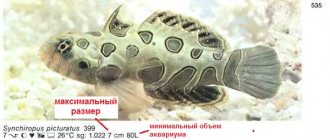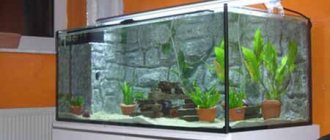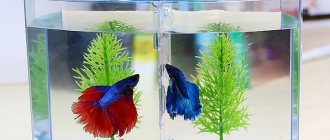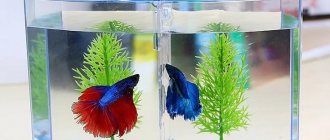The depths of the salty oceans and seas hide many secrets, so they have remained a mystery to man for centuries. Wanting to touch the amazing underwater world, aquarists purchase marine fish - aquarium inhabitants, striking in their abundance of shapes and colors. Despite the fact that a huge number of phenotypes live in the depths of the oceans, not every fish is suitable for a salt water aquarium - marine inhabitants are freedom-loving, and do not tolerate confined spaces well. Before purchasing colorful and attractive marine fish, you should learn more about the characteristics and conditions of keeping the phenotypes.
How to choose fish for a marine aquarium
Watching the colorful and graceful sea fish swimming peacefully surrounded by fabulous underwater flora and bright corals, you should understand that the inhabitants of the seas and oceans are accustomed to freedom. Not every inhabitant of salt waters is able to exist in a home aquarium, even if the size of the reservoir is large. Therefore, when choosing marine fish for an aquarium, you need to start from the tank capacity that the aquarist can afford.
Bristletoothed (butterfly fish) - chaetodontidae
- Butterfly
- Blackfin Butterfly
- Pakistani butterfly (chocolate yellow)
- Black-backed butterfly
- Butterfly
- Klein's purple-spotted butterfly
- Milk butterfly
- Butterfly - raccoon
- Butterfly Maera
- Eight-banded butterfly
- Crowned butterfly
- Butterfly decorated
- Spotted butterfly
- Butterfly Raffla
- Masked butterfly
- Redfin chevron butterfly
- Gunther's butterfly
- Tweezer-helmon butterfly
- Butterfly tweezers yellow
- Brown pennant butterfly
- Parachaetodon ocellata
- White-feathered pennant butterfly
- Red Sea pennant butterfly, Red Sea Kabuba
- Philippine orange-tailed pennant butterfly
For small bodies of water
The main difficulties that owners of small salt water aquariums face when selecting residents are:
- Fish compatibility – when purchasing pets, it is important to consider the compatibility of phenotypes with other species.
- Tank care - in small aquariums, algae grow faster, which requires additional time and effort on the part of the owner.
Therefore, when choosing fish for a medium-sized saltwater aquarium, the owner should carefully consider the cleaning schedule and provide for the compatibility of the inhabitants so that there are no fights or skirmishes in the tank. The best option for populating a small reservoir would be calm and peaceful phenotypes with a body length of no more than 5-6 cm.
Curlyfins, stickfins, wrasse, parrotfish
- Kudreper - falcon
- Red-spotted curlew
- Neocirritum prickly
- Long-snouted querlin
- Large-scaled red-cheeked curlew
- Bodian mesothorax
- Cirrilabrus sp.
- Koris the clown, Aigula
- Yellowtail Junker / Juv.
- Wrasse - snipe (male, female)
- Tamarin yellow
- Red-banded tamarin
- Arabian cleaner wrasse
- Wrasse doctor
- Doctor wrasse bicolor
- Lienardella cranstriped
- Eight-lined Red Sea wrasse
- Pseudocheilin six-banded
- Thalassoma iris
- Thalassoma lunarum [green]
- Thalassoma five-stripe
For large aquariums
If an aquarist can afford to install a huge salt water aquarium at home, then there will be fewer problems with selecting fish. However, there are difficulties here too: realizing that the size of the container allows you to stock many fish, novice aquarists grab all the ones they like indiscriminately, without taking into account the compatibility and habits of the fish. To avoid sad consequences, before buying fish you need to pay attention to the following points:
- Features of the phenotype - many marine aquarium fish are poisonous, so it is better to find out about such unexpected surprises in advance.
- Taste preferences - you should familiarize yourself with the eating habits of the fish before purchasing, so that the resident does not turn out to be a predator and does not eat his neighbors. In addition, the owner will be offended if the fish suddenly gnaws corals or plants instead of food.
- Character plays a big role, since aggressive phenotypes can offend weak neighbors.
These are the key points that you should study before purchasing the fish you like. To avoid getting into trouble, it will be useful for a novice aquarist to familiarize himself with the list of popular fish for marine waters, which contains descriptions and characteristics of phenotypes.
Varieties
Many species are commercially available and are divided into families. Names of sea fish:
- perch;
- horse mackerel;
- sturgeon;
- scorpionfish;
- steam;
- croakers;
- salmon;
- herrings;
- nototheniaceae;
- cod;
- flounder.
There are others, such as the shark family. Some species of marine representatives are classified as elite breeds, while a number of others are caught in most port cities in industrial quantities.
cod
Representatives of this group are more than 100 species of fish. Of the cod family, only burbot is able to live in fresh water.
This group prefers cold water, so it is most often found in the Atlantic Ocean and in the seas of the Northern Hemisphere. Most individuals prefer to move in small groups. They are distinguished by a developed caudal fin and the presence of two dorsal fins. The cod family includes:
- cod;
- burbot;
- haddock;
- Pacific pollock;
- navaga.
Cod species, which feed on plankton, are small marine fish. Individuals that prefer larger marine inhabitants as food are distinguished by their large dimensions.
Cod
Mackerel family
Representatives of mackerel prefer a pelagic lifestyle, that is, they do not sink to the bottom. Their body structure allows them to be good swimmers and move quickly through the water.
Examples of family members:
- mackerel;
- tuna;
- bonito.
This group inhabits the seas of temperate, subtropical and tropical latitudes.
Mackerel
Flounder
The body shape of flounders is often oval or diamond-shaped. These species live along the bottom surface. Some of them prefer shallow water, while a number of others like to stand in the depths.
The group includes:
- flounder;
- halibut;
- Kalkan;
- sole.
Flounders are found along the entire coast of Eurasia and in the seas within the continent.
Flounder
Herrings
Representatives of this group are distinguished by the absence of scales on their heads. They are the most important commercial fish. The family includes:
- herring;
- belly;
- herring;
- anchovy;
- sprat;
- European sardine.
More often found in northern latitudes.
The most popular marine breeds
A list of the most interesting aquarium fish of marine origin that have adapted to life in artificial reservoirs will help you create a mini-sea at home with colorful and vibrant inhabitants.
Parrot fish
The parrotfish, or Bleker's chlorurus, received its original name due to its external similarity with feathered creatures - representatives of the species boast not only colorful “plumage”, but also a funny beak in the front of the head. Colors and color intensity vary among representatives, but these aquarium marine fish are generally colored in shades of blue, violet and pinkish.
The diet of parrots consists of invertebrates - with a powerful beak, the fish tears off a piece of the coral reef and grinds it into sand, eating the living creatures. The presence of corals in a home aquarium is mandatory. Representatives of the species are impressive in size, so to keep parrots you will need an aquarium with a capacity of at least a ton. In small tanks, the parrot fish becomes embittered and attacks its neighbors.
Blue surgeon
The surgeon family includes more than 80 species, but the favorite and most popular is the variety called the blue surgeon. A distinctive feature of this phenotype is a sharp plate near the tail, reminiscent of a scalpel, and is a weapon against enemies.
The blue surgeon is a peace-loving and calm fish, with a noble color of intense blue and a yellow tail. At home, these aquarium sea fish grow up to 15 cm, and a couple of representatives will require a tank with a capacity of 400 liters or more. The surgeon fish has a good appetite, but if there is a shortage of food, it will encroach on corals.
Triggerhorn clown
The clown triggerfish is a beautiful, rare and expensive pet that, if provided with good conditions, can live a long life. The appearance of the fish is memorable: the upper body is painted jet black, and the tummy is decorated with round light spots. There is a yellow mark of thin stripes on the back, the mouth is bordered by a yellow line.
It is important to know that the clown triggerfish is not characterized by a peaceful nature - this marine inhabitant is aggressive, can attack neighbors and even damage aquarium equipment. For one fish you will need a container of 400 liters.
Fire Angel
Fire angels are popular saltwater fish for saltwater aquariums, but are picky about their housing conditions. They are peaceful and friendly towards their neighbors, feeding on both plant and living food. Fire angels grow up to 12 cm in length and have a bright color: a scarlet body decorated with black stripes. To keep two angelfish, you will need a container of at least 400 liters.
Zebrasoma
Zebrasoma is a bright representative of the Surgical family, with a rich yellow color. Representatives of the species are inquisitive and can be kept in groups, but when purchasing, please note that 200 liters are required for one fish. The diet of zebrafish consists mainly of plant foods, but the fish will not refuse live food.
Clown fish
Clown fish are picturesque marine inhabitants, distinguished by their bright appearance and calm disposition. The genus of these creatures includes over 30 species, among which the white-brown and tomato clowns are popular.
Interestingly, clown fish are immune to the venom of sea anemones, which they acquire after numerous contacts with poisonous anemones. In addition, these aquarium marine fish breed easily in captivity, unlike other phenotypes.
Chrysiptera
Sapphire chrysiptera is a small fish with expressive eyes, painted in blue tones. In addition to the sapphire, there is a yellow-tailed variety that has a bright yellow caudal fin.
Chrysipters have difficulty getting along even with fish of their own species, but if you introduce young animals of the same age into the aquarium, then there is a chance of a friendly community.
Royal Gramma
The color of the Royal Gramma combines two colors: the front part of the body is bright crimson, and the back part is lemon yellow. Despite their external fragility and attractiveness, grams have a tough character and fiercely defend their territory. When keeping royal grams at home, you should know that one fish requires 100-150 liters of liquid, shelter and grottoes.
Anthias
The anthias family includes over 200 species, each of which is beautiful and attractive in its own way. The most popular is Plectranthias alicofin, which grows up to 4.5 cm in length. The fish are unpretentious in keeping, and for complete happiness, pets only need a lot of shelters.
Wrasse pajamas
Pajama wrasse are marine aquarium fish that are considered one of the most beautiful inhabitants of salt waters. They are territorial and aggressive towards their neighbors, but are of great benefit in the tank, destroying parasites. The color of wrasses is striped, including shades of crimson, lilac, blue and green. They prefer sandy soil and plenty of cover to rest at night.
sea cockerel
The cockerel is a secretive and mysterious inhabitant of the seas, which prefers to lead a twilight lifestyle, spending most of its time in shelters and in the shade. A distinctive feature is the presence of lush fin-processes, with the help of which the fish feels the bottom.
Neighbors play an important role for the betta - aquarium sea fish should be peaceful, since aggressive phenotypes will cause the pet to hide a lot and die from exhaustion. The cockerel will eat small and weak neighbors.
Groupers, anthias, grams, plesiops, apogons, horse mackerel, red mullet, platax
- Red coral grouper
- Fire grouper
- Leopard grouper
- Variola iris
- Anthias lyrebird
- Anthias pearl royal
- Antias - square (Malevich)
- Falsechromis diadema
- Falsechromis yellowback
- Falsechromis Friedman
- Falsechromis regal
- Falsechromis violet
- Falsechromis Springer
- Calloplesiops comet
- Kaudern apogon tulle
- Spheromy spotted
- Golden karang
- Imperial red snapper
- Sweetlip spotted
- Platax blue
- Platax bat











